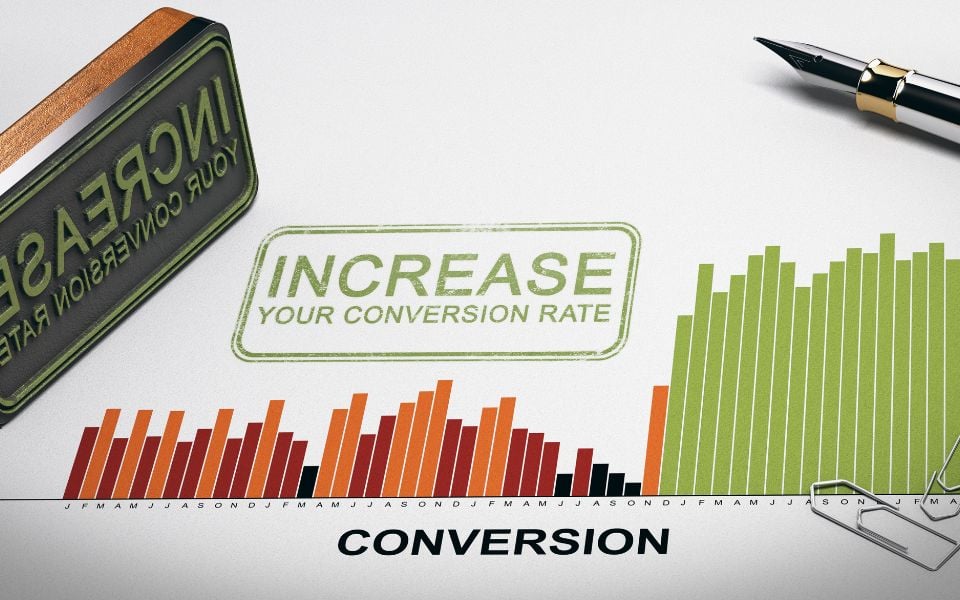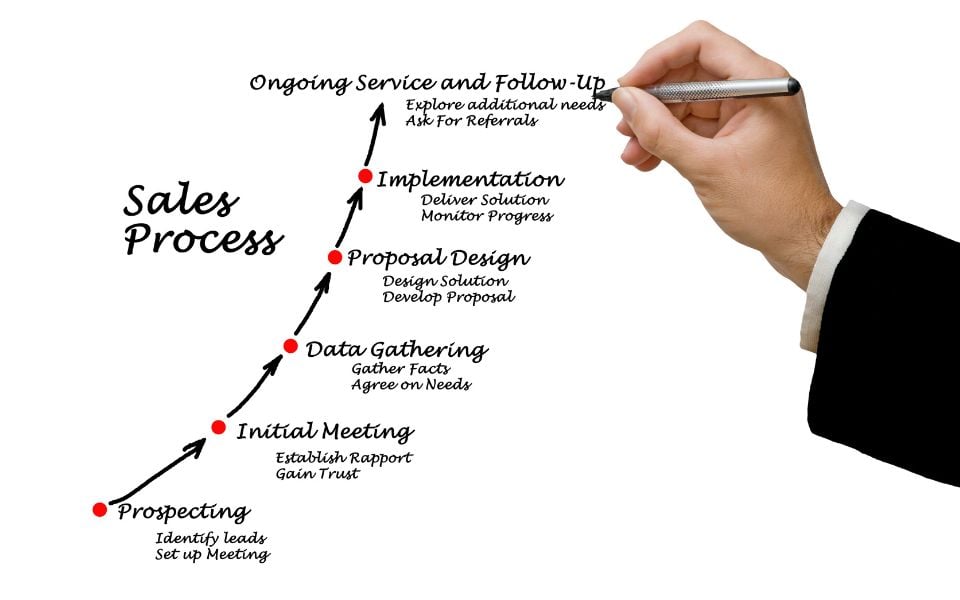Sales Lead Generation Tools: The Ultimate Guide For Sales Managers
Welcome to our ultimate guide for sales lead generation tools, designed specifically for sales managers like you. If you're like most sales professionals, you've likely struggled with identifying the right sales leads at some point in your career. It can feel like finding a needle in a haystack, but the truth is, identifying sales leads is crucial for meeting your sales targets and reducing labour costs. But don't worry, this is where sales lead generation tools come in - think of them as your treasure map for sales.
In this guide, we'll take a deep dive into what sales lead generation tools are, how they work, and how to choose the right ones for your team. We'll also explore the role of HubSpot in sales lead generation and show you how to use their sales tools to generate leads. As a certified HubSpot partner and marketing automation agency, we know firsthand how powerful these tools can be.
But before we get into the nitty-gritty of sales lead generation tools, let's set the scene. Have you ever found yourself wasting time with prospects who aren't ready to buy or simply not interested? It's a common pain point for sales managers and one that can be easily solved with the right tools. By the end of this guide, you'll have a better understanding of how to use sales lead generation tools to streamline your sales process and increase your ROI.

We know that as a sales manager, you're time-poor and have a lot on your plate. That's why we've put together this guide to make it easy for you to find the information you need. We'll be using analogy to make it more relatable and easy to understand. So, whether you're looking to improve your sales strategy or simply want to learn more about sales lead generation tools, you've come to the right place.
The Struggle of Identifying Sales Leads
As a sales professional, you're likely familiar with the feeling of searching for a needle in a haystack when it comes to identifying sales leads. It can be frustrating and time-consuming, but the truth is, finding the right leads is crucial for meeting your sales targets and reducing labour costs. But, just like finding a needle in a haystack can be a blessing in disguise, so too can the struggle of identifying sales leads lead you to the solution of using sales lead generation tools.
The Importance of Sales Lead Generation Tools
Sales lead generation tools are an essential part of any sales automation strategy. They allow you to streamline your sales process, increase your ROI, and most importantly, identify the right leads for your business. Think of them as your treasure map for sales, guiding you to the prospects that are most likely to convert. With the right sales lead generation tools, you can focus on building relationships with qualified leads, rather than wasting time with those who aren't ready to buy.
The Role of HubSpot in Sales Lead Generation
HubSpot is a leading sales and marketing software that offers a range of tools to help you generate leads and automate your sales process. As a certified HubSpot partner, we know firsthand how powerful these tools can be. From their CRM to their sales and email tools, HubSpot provides a comprehensive solution for sales lead generation. With HubSpot, you can think of your sales process as a journey and HubSpot as the GPS, guiding you to your destination of meeting sales targets and reducing labour costs.
Understanding Sales Lead Generation Tools

In this section, we will delve deeper into what sales lead generation tools are, the different types of tools available, and how they work to help you identify and qualify leads for your business.
Definition of Sales Lead Generation Tools
At its core, a sales lead generation tool is any software or platform that helps you identify and qualify leads for your business. These tools can range from simple contact lists to more advanced solutions that incorporate automation, analytics, and other features. The goal of sales lead generation tools is to help you find the right leads and streamline your sales process, ultimately unlocking your sales potential.
Types of Sales Lead Generation Tools
There are many different types of sales lead generation tools available, each with its own set of features and capabilities. Some popular types of sales lead generation tools include:
- Contact management software, which helps you organise and manage your leads
- Marketing automation software, which allows you to automate and track your marketing campaigns
- Lead generation software, which helps you find new leads through various methods such as web forms, landing pages, and lead magnets
- Sales enablement software, which provides sales team with the tools they need to communicate and engage with leads
- Sales intelligence software, which gives you insights into your leads and competitors
Think of these sales lead generation tools as the different tools in a toolbox, each one with its own purpose and function, and together they will help you to achieve your sales objectives.
How Sales Lead Generation Tools Work
Sales lead generation tools work by collecting, analysing, and qualifying leads for your business. The process typically starts with lead capture, where potential leads are identified through various methods such as web forms, landing pages, and lead magnets. Once leads are captured, they are added to a contact database where they are analysed and qualified based on certain criteria, such as demographics, behaviour, and interests.
Finally, qualified leads are passed on to the sales team for follow-up and nurturing. Think of the sales lead generation tool as the engine that drives your sales process, constantly collecting and analysing data to help you find the right leads and streamline your sales process.
Identifying the Right Sales Lead Generation Tools
Finding the right sales lead generation tools can be a daunting task, but with the right approach, you can find the tools that will best suit your business and help you achieve your sales goals.
Assessing Your Sales Needs
Before you can choose the right sales lead generation tools, it's important to assess your sales needs. This means taking a look at your current sales process, identifying any pain points or areas for improvement, and determining what kind of leads will be most valuable to your business. For example, if you're struggling with lead capture, you may want to consider a tool that specialises in lead generation. On the other hand, if you're having trouble keeping track of your leads, a contact management tool may be more suitable. Think of assessing your sales needs as tailoring a sales suit, it needs to fit your specific needs and preferences.
Evaluating Available Tools
Once you've assessed your sales needs, it's time to evaluate the available tools. This means researching different sales lead generation tools and comparing their features, pricing, and user reviews. It's important to keep in mind that the best tool for one business may not be the best for another, so be sure to consider your specific needs and budget. Think of evaluating available tools as testing the waters of sales, you need to try different things to see what works best for you.
Choosing the Best Tools for Your Team
After you've assessed your sales needs and evaluated the available tools, it's time to choose the best tools for your team. This means considering not only the features of the tools, but also how they will integrate with your existing systems and how easy they will be for your team to use. Keep in mind that the success of your sales lead generation efforts depends not only on the tools you choose, but also on how well your team is trained to use them. Think of choosing the best tools for your team as building the perfect sales team, you need to have the right people and the right tools to achieve success.
The Importance of Sales Lead Scoring

Lead scoring is crucial for identifying and prioritising your best leads. By assigning a score to each lead based on their behaviour and engagement, you'll be able to focus your efforts on the leads that are most likely to convert. This can help you to increase your conversion rates and ultimately close more sales.
How Sales Lead Scoring Works
Sales lead scoring works by assigning a score to each lead based on their behaviour and engagement. This includes factors such as website visits, form submissions, email engagement, and more. Think of it as a game of points, the more points a lead has, the more likely they are to convert.
How to Implement Sales Lead Scoring
Implementing sales lead scoring involves setting the criteria for scoring, such as the specific behaviours and engagement that will be taken into account. It also involves setting the threshold for what constitutes a "good" lead score. Think of it as setting the rules for the game, once they're in place, it's time to play.
Tips for Successful Sales Lead Scoring
To ensure a successful sales lead scoring, it's important to consider the following tips:
- Regularly review and update your lead scoring criteria.
- Test your lead scoring system before rolling it out to your team.
- Train your team on how to use the lead scoring system.
- Use your lead scores to prioritise your follow-up efforts. By following these tips, you'll be able to play the game to win, by focusing on the leads that are most likely to convert.
The Importance of Lead Nurturing
Lead nurturing is the secret for turning leads into customers and meeting your sales targets. By consistently providing valuable content and communication to leads over time, you'll be able to build trust and relationships with them, making them more likely to convert. This can help you to increase your conversion rates and ultimately close more sales.
How Lead Nurturing Works
Lead nurturing works by consistently providing valuable content and communication to leads over time. By providing them with relevant information and keeping them engaged, you'll be able to build trust and relationships with them. Think of it as planting a seed, the more you nurture it, the more it will grow.
How to Implement Lead Nurturing
Implementing lead nurturing involves creating a lead nurturing sequence and providing relevant content and communication to leads at each stage of the buying process. It also involves regularly reviewing and updating your lead nurturing strategy to ensure it's still meeting your needs. Think of it as cultivating a garden, it takes time and effort but the end result is worth it.
Tips for Successful Lead Nurturing
To ensure a successful lead nurturing, it's important to consider the following tips:
- Segment your leads based on their behaviour and engagement.
- Create a lead nurturing sequence tailored to each segment.
- Provide relevant content and communication at each stage of the buying process.
- Use automated lead nurturing tools to save time and increase efficiency. By following these tips, you'll be able to reap the harvest of increased conversion rates and closed sales.
The Importance of Sales Funnel Optimization

By regularly analysing and making adjustments to your sales funnel, you'll be able to identify and remove any bottlenecks, increasing the flow of leads through your funnel and ultimately closing more sales.
How Sales Funnel Optimization Works
Sales funnel optimization works by regularly analysing and making adjustments to your sales funnel in order to increase conversion rates and close more sales. This includes identifying and removing bottlenecks, testing different elements of the funnel and making changes to improve the flow of leads through the funnel. Think of it as fine-tuning an engine, small adjustments can make a big difference in performance.
How to Optimise Your Sales Funnel
Optimising your sales funnel involves regularly analysing your data and identifying bottlenecks in the funnel. Once you've identified the problem areas, you can test different solutions and make changes to improve the flow of leads through the funnel. Think of it as diagnosing and fixing a problem, once you find the issue, you can take steps to solve it.
Tips for Successful Sales Funnel Optimization
To ensure a successful sales funnel optimization, it's important to consider the following tips:
- Regularly review and analyse your sales funnel data.
- Test different elements of the funnel and make changes to improve the flow of leads.
- Use A/B testing to compare the results of different changes.
- Use analytics to track the success of your optimization efforts. By following these tips, you'll be able to achieve peak performance and increase your conversion.
The Importance of Sales Forecasting

Why sales forecasting?
It is for planning and preparing for future sales. By forecasting future sales, you'll be able to make informed decisions, set realistic goals, and allocate resources effectively.
How Sales Forecasting Works
Sales forecasting works by analysing past sales data and trends to predict future sales. Think of it as weather forecasting, by understanding the patterns and trends, you can make informed decisions about what to expect in the future.
How to Implement Sales Forecasting
Implementing sales forecasting involves regularly analysing past sales data and trends, and using that information to predict future sales. It also involves regularly reviewing and updating your forecast to ensure it's still accurate. Think of it as planning a road trip, by understanding the journey ahead, you can make informed decisions and prepare for the future.
Tips for Successful Sales Forecasting
To ensure a successful sales forecasting, it's important to consider the following tips:
- Regularly analyse past sales data and trends.
- Use forecasting tools and software to automate and streamline the process.
- Set clear and measurable goals for your sales performance.
- Use the data to identify patterns and trends.
- Regularly review and update your forecast to ensure it's still accurate.
By following these tips, you'll be able to navigate the journey ahead, by making informed decisions and preparing for future sales.
The Importance of Sales Performance Metrics

Understanding your sales performance and making data-driven decisions makes a big difference. By regularly monitoring key metrics such as conversion rates, win/loss ratio, and sales pipeline stages, you'll be able to identify areas for improvement and make adjustments to increase your sales performance.
Key Sales Performance Metrics
There are several key sales performance metrics that are important to track and analyse, including conversion rates, win/loss ratio, sales pipeline stages, and more. Think of it as keeping score, by understanding your performance, you can make adjustments to increase your results.
How to Track and Analyze Sales Performance Metrics
Tracking and analysing sales performance metrics involves regularly monitoring key metrics and using that data to identify areas for improvement. This can be done using sales performance management software or by manually tracking the data in a spreadsheet. Think of it as reading the playbook, by understanding the strategies and tactics, you can make adjustments to improve your performance.
Tips for Successful Sales Performance Metrics
To ensure a successful analysis of sales performance metrics, it's important to consider the following tips:
- Regularly track and analyse key metrics.
- Use sales performance management software to automate and streamline the process.
- Set clear and measurable goals for your sales performance.
- Use the data to identify areas for improvement and make adjustments.
- Regularly review and update your metrics to ensure they are still relevant.
By following these tips, you'll be able to win the game, by making data-driven decisions and improving your sales performance.
The Importance of Sales Automation

Automating repetitive and time-consuming tasks is key for increasing efficiency, freeing up time for more important tasks, and ultimately closing more sales. By implementing sales automation tools and processes, you'll be able to streamline your workflow and focus on the most important tasks, leading to increased productivity and better sales results.
How Sales Automation Works
Sales automation works by implementing tools and processes that automate repetitive and time-consuming tasks, such as email and calendar management, lead scoring, and more. Think of it as building a machine, by automating certain tasks, you can increase efficiency and free up time for more important tasks.
How to Implement Sales Automation
Implementing sales automation involves researching and selecting the right tools for your business, and then implementing and training your team on how to use them. It also involves regularly reviewing and updating your automation processes to ensure they are still meeting your needs. Think of it as assembling the pieces of a machine, once all the parts are in place, you can start using it to increase efficiency.
Tips for Successful Sales Automation
To ensure a successful sales automation, it's important to consider the following tips:
- Research and select the right tools for your business.
- Implement and train your team on how to use the tools.
- Regularly review and update your automation processes to ensure they are still meeting your needs.
- Use automation tools to streamline repetitive and time-consuming tasks, such as email and calendar management, lead scoring, and more.
- Continuously monitor and measure the results of your automation efforts to ensure they are providing a positive ROI.
By following these tips, you'll be able to keep the machine running smoothly and achieve better sales results through increased efficiency and productivity.
The Importance of Sales Coaching

Regular sales coaching is essential for improving the skills and performance of your sales team. By providing ongoing training, feedback, and support, you'll be able to help your team members reach their full potential and achieve better sales results.
How Sales Coaching Works
Sales coaching works by providing ongoing training, feedback, and support to help improve the skills and performance of your sales team. Think of it as training an athlete, by providing the right guidance and resources, you can help them reach their full potential.
How to Implement Sales Coaching
Implementing sales coaching involves creating a sales coaching program and providing regular training, feedback, and support to your sales team. It also involves regularly reviewing and updating your coaching program to ensure it's still meeting the needs of your team. Think of it as building a winning team, by providing the right guidance and resources, you can help them achieve success.
Tips for Successful Sales Coaching
To ensure a successful sales coaching, it's important to consider the following tips:
- Develop a sales coaching program that includes regular training, feedback, and support.
- Use a variety of coaching methods, such as one-on-one coaching, group coaching, and e-learning.
- Use performance metrics to track the progress of your team members.
- Regularly review and update your coaching program to ensure it's still meeting the needs of your team.
- Encourage ongoing learning and development for your sales team. By following these tips, you'll be able to achieve victory by improving the skills and performance of your sales team.
It's important to remember that coaching is an ongoing process, and it takes time and effort to see the results, but with the right approach and the right mindset, you can help your sales team to be the best they can be, and achieve your sales goals.
The Importance of Sales Reporting and Analytics

Like ongoing coaching, regular reporting and analytics are helpful for understanding and improving your sales performance. By tracking key metrics and analysing data, you'll be able to make data-driven decisions and optimise your sales process.
Key Sales Metrics to Track
There are several key sales metrics that are important to track, including conversion rates, win/loss ratio, sales pipeline stages, and more. Think of it as keeping score, by understanding your performance, you can make adjustments to increase your results.
How to Report and Analyze Sales Data
Reporting and analysing sales data involves regularly monitoring key metrics and using that data to make decisions and optimise your sales process. This can be done using sales performance management software or by manually tracking the data in a spreadsheet. Think of it as reading the playbook, by understanding the strategies and tactics, you can make adjustments to improve your performance.
Tips for Successful Sales Reporting and Analytics
To ensure a successful sales reporting and analytics, it's important to consider the following tips:
- Regularly track and analyse key metrics.
- Use sales performance management software to automate and streamline the process.
- Set clear and measurable goals for your sales performance.
- Use the data to identify areas for improvement and make adjustments.
- Regularly review and update your metrics to ensure they are still relevant.
By following these tips, you'll be able to win the game, by making data-driven decisions and improving your sales performance.
HubSpot Sales Tools Overview

Now let's take a closer look at the specific sales tools offered by HubSpot, including their CRM, Sales, and Sales Email features. As a HubSpot certified partner, we have experience using these tools to help our clients generate leads and streamline their sales process.
HubSpot CRM
The HubSpot CRM is a free and powerful customer relationship management tool that helps you manage and track your leads, deals, and contacts. It also allows you to track your team's activity and performance, giving you a clear picture of your sales pipeline. Think of the HubSpot CRM as the hub of your sales operations, it connects all the different aspects of your sales process and allows you to manage them in one place.
HubSpot Sales
The HubSpot Sales tool is a powerful sales automation tool that allows you to personalise your sales process and engage with your leads more effectively. It includes features such as email tracking, meeting scheduling, and personalised email sequences, which allow you to tailor your sales approach to each lead. Think of the HubSpot Sales tool as the power of personalization, it allows you to adapt your sales approach to each lead, making it more effective.
HubSpot Sales Email
The HubSpot Sales Email tool is a powerful sales communication tool that allows you to create, send, and track personalised emails to your leads. It includes features such as email templates, email sequencing, and email tracking, which help you to communicate more effectively with your leads. Think of the HubSpot Sales Email tool as the art of sales communication, it allows you to communicate more effectively with your leads and increase your chances of converting them into customers.
HubSpot Sales Email Templates
HubSpot Sales Email Templates is a tool that allows sales teams to create and use pre-designed email templates for their sales campaigns. Sales teams can use the tool to create and store templates for different types of emails such as follow-up emails, introduction emails, and proposal emails.
HubSpot Sales Email Tracking
HubSpot Sales Email Tracking is a tool that allows sales teams to track the open and click-through rates of their emails, as well as the activity of the leads or contacts who received the emails. Sales teams can use the tool to understand the engagement level of their leads and optimise their email campaigns accordingly.
HubSpot Email Sequences
HubSpot Email Sequences is a tool that allows sales teams to automate their email communication with leads and contacts. Sales teams can use the tool to create a series of pre-written emails that will be sent out automatically to leads or contacts based on certain triggers, such as form submission or lead status change.
HubSpot Meetings
HubSpot Meetings is a tool that allows sales teams to schedule and conduct virtual meetings with prospects and customers. It includes features such as calendar syncing, automated email reminders, and the ability to join meetings with a single click. This helps sales teams save time and increase efficiency by streamlining the scheduling process.
HubSpot Live Chat
HubSpot Live Chat is a tool that allows sales teams to interact with website visitors in real-time through a chat widget. Sales teams can use the tool to answer questions, provide support, and even qualify leads in real-time. This can help increase conversions and boost sales.
HubSpot Video
HubSpot Video is a tool that allows sales teams to create, host, and track videos for use in their sales process. Sales teams can use the tool to create product demos, customer testimonials, and other types of sales videos. This allows sales teams to engage prospects in a more visual and interactive way and build stronger relationships with their leads.
HubSpot Sales Calls
HubSpot Sales Calls is a tool that allows sales teams to make and receive calls directly from their HubSpot account. Sales teams can use the tool to log calls, track call duration, and even schedule callbacks.
HubSpot Sales Reports
HubSpot Sales Reports is a tool that allows sales teams to view and analyse their sales data in real-time. Sales teams can use the tool to track key performance indicators (KPIs) such as lead conversion rate, deal close rate, and pipeline data, and use this data to optimise their sales performance.
HubSpot Sales Forecasting
HubSpot Sales Forecasting is a tool that allows sales teams to predict future sales based on historical data. Sales teams can use the tool to forecast revenue, pipeline, and other key metrics, and use this data to plan and budget accordingly.
HubSpot Sales Productivity
HubSpot Sales Productivity is a set of tools that helps sales teams stay organised and productive. This includes features such as task management, notes, and the ability to set reminders, which help sales teams stay on top of their to-do list and prioritise their tasks.
HubSpot Sales API
HubSpot Sales API is a tool that allows sales teams to connect HubSpot with other third-party applications. Sales teams can use the API to automate workflows, integrate data, and build custom integrations to streamline their sales process.
HubSpot Sales AI
HubSpot Sales AI is a set of AI-powered features that helps sales teams identify potential leads, predict which leads are most likely to convert, and automate certain aspects of the sales process. It includes features such as AI-powered lead scoring, which uses machine learning to analyse a lead's behaviour and engagement with your website and sales content to predict which leads are most likely to convert.
HubSpot Sales Mobile App
HubSpot Sales Mobile App is a tool that allows sales teams to access and manage their sales data and tools on-the-go using their mobile device. Sales teams can use the app to view and update leads, track email and call logs, and even schedule meetings while they are out of the office.
HubSpot Sales Docs
HubSpot Sales Docs is a tool that allows sales teams to create, store, and share sales collateral and other documents with prospects and customers. Sales teams can use the tool to create proposals, contracts, and other types of sales documents, and track how those documents are being viewed and interacted with.
HubSpot Sales Proposal
HubSpot Sales Proposal is a tool that allows sales teams to create, send, and track professional-looking proposals. Sales teams can use the tool to create proposals, add pricing tables, and include e-signature capabilities so prospects can sign the proposal directly from their email.
HubSpot Sales Live Chat
HubSpot Sales Live Chat is a tool that allows sales teams to interact with website visitors in real-time through a chat widget. Sales teams can use the tool to answer questions, provide support, and even qualify leads in real-time.
HubSpot Sales Playbooks
HubSpot Sales Playbooks is a tool that allows sales teams to access pre-defined best practices and playbooks for different sales stages and activities. Sales teams can use the tool to get guidance and tips on how to move leads through the sales funnel, and how to handle specific sales scenarios.
HubSpot LinkedIn Sales Navigator Integration
HubSpot LinkedIn Sales Navigator Integration is a tool that allows sales teams to connect HubSpot with LinkedIn Sales Navigator, to gain access to advanced lead data and insights about their prospects. By integrating with LinkedIn Sales Navigator, sales teams can quickly identify and connect with decision-makers, view lead details, and receive lead recommendations based on their search criteria.
HubSpot CRM for Lead Management

By using HubSpot's lead management features, you'll be able to organise, prioritise, and track your leads, making it easier to close deals and increase sales. We'll be providing examples of how this can be done using the HubSpot platform.
Organising and Prioritising Leads - Sorting Through the Gold and the Dirt
The HubSpot CRM allows you to organise and prioritise your leads by using the lead scoring feature. This can be done by assigning points to different lead properties such as job title, company size, and lead source. By using lead scoring, you'll be able to prioritise the leads that are most likely to close, and focus on the most valuable opportunities.
Tracking Lead Activity
The HubSpot CRM allows you to track lead activity by using the lead timeline feature. This feature allows you to see all the interactions a lead has had with your company, such as emails sent, forms submitted, and website visits. By tracking lead activity, you can see which leads are engaged and which leads need more attention.
Assigning Leads to Sales Team Members
The HubSpot CRM allows you to assign leads to specific sales team members by using the lead owner feature. This feature allows you to assign a lead owner to each lead, which is then responsible for following up and nurturing the lead. By assigning leads to specific sales team members, you can ensure that each lead is getting the attention it needs.
As an example, let's say that you're a sales team lead and you have a team of five sales representatives. You can use the lead owner feature to assign leads to each of your team members, such as John, Mary, Sarah, Michael and David, based on the lead's location, industry or any other criteria you choose. This way, John is responsible for leads that come from New York, Mary for leads that come from the healthcare industry, Sarah for leads that come from the software industry, Michael for leads that come from the retail industry and David for leads that come from the finance industry.
How to Use HubSpot Sales Tools to Generate Leads
For the implementation of any sales tools let look at how to effectively use the HubSpot sales tools to generate leads and streamline your sales process. From setting up the tools and implementing best practices, to measuring your results using the HubSpot platform, we've got you covered. So sit back, relax and enjoy your coffee (or tea) as we take you on a journey of lead generation bliss!
Setting Up Your HubSpot Sales Tools
The first step in using the HubSpot sales tools to generate leads is setting them up. This includes configuring the settings, connecting the tools to your existing systems, and training your team on how to use them. It may seem daunting at first but think of setting up your HubSpot sales tools as building a sandcastle, it may take time but the end result is worth it.
Leveraging HubSpot's Lead Generation Features
Once your HubSpot sales tools are set up, it's time to leverage the platform's lead generation features. This includes creating a lead magnet, setting up lead capture forms, and creating a lead nurturing sequence. With the power of HubSpot's lead generation features, you'll be able to generate leads like never before! It's like receiving a blessing from the lead generation gods.
Measuring and Optimising Your Results with HubSpot's Analytics
Finally, it's important to measure and optimise your results using HubSpot's analytics. This means tracking your lead generation efforts, analysing your data, and making adjustments to improve your results. Think of it as reading the tea leaves of sales, the data will guide you on your sales strategy. By regularly tracking and analysing your results, you'll be able to see which lead generation strategies are working and which need to be tweaked. This will help you to optimise your efforts and increase your ROI, ultimately leading to more leads and more sales.
HubSpot Sales for Sales Automation
HubSpot Sales tools can help you automate your sales process and improve your sales performance.
Creating Sales Templates
The HubSpot Sales tool allows you to create sales templates, which can be used as a blueprint for your sales process. By creating sales templates, you can ensure that your sales team is following a consistent and effective process, which can lead to more successful sales. Think of it as a blueprint for sales success, by having a consistent process in place, you can increase your sales and improve your sales performance.
Automating Sales Workflows
The HubSpot Sales tool allows you to automate your sales workflows, which can streamline your sales process and save your team time. By automating repetitive tasks such as email follow-ups, you can free up your team to focus on more important tasks. Think of it as streamlining the sales machine, by automating repetitive tasks, you can save your team time and increase your sales performance.
Measuring Sales Performance
The HubSpot Sales tool allows you to measure your sales performance by using the built-in reporting and analytics features. This allows you to see how your team is performing, identify areas for improvement, and make data-driven decisions. Think of it as analysing the sales scorecard, by measuring your sales performance, you can see how your team is performing, identify areas for improvement, and make data-driven decisions.
As an example, let's say that you're a sales manager and you want to automate the follow-up process for leads that haven't been contacted in a while. You can use the HubSpot Sales tool to create a workflow that sends an automated email to leads that haven't been contacted in a while, reminding them of your company's products or services and asking if they are still interested in learning more. This way, you can ensure that your team doesn't miss out on any potential sales opportunities.
HubSpot Sales Email for Lead Generation

HubSpot Sales Email tool can help you generate leads and improve your email marketing efforts. Email is still one of the most effective ways to reach out to potential customers and generate leads, and using the right tools can help you make the most of your email campaigns.
Personalised Email Campaigns
The HubSpot Sales Email tool allows you to create personalised email campaigns, which can help you build better relationships with your leads and increase your sales. By using the tool's personalization features, you can create more targeted and effective email campaigns that speak directly to your leads' interests and needs. Think of it as the personal touch in sales, by creating personalised email campaigns, you can build better relationships with your leads and increase your sales.
Email Tracking and Reporting
The HubSpot Sales Email tool allows you to track and report on your email campaigns, so you can see which campaigns are working and which ones aren't. By using the tool's tracking and reporting features, you can see which leads are opening your emails, clicking through to your website, and converting into customers. Think of it as keeping tabs on sales, by tracking and reporting on your email campaigns, you can see which campaigns are working and which ones aren't.
A/B Testing for Email Campaigns
The HubSpot Sales Email tool allows you to A/B test your email campaigns, so you can see which elements of your emails are working and which ones aren't. By using the tool's A/B testing features, you can test different subject lines, email layouts, and call-to-action buttons to see which elements are most effective. Think of it as fine-tuning the sales pitch, by A/B testing your email campaigns, you can see which elements are most effective and improve your email marketing efforts.
As an example, let's say that you're a B2B company looking to generate leads from LinkedIn. You can use the HubSpot Sales Email tool to create a campaign that targets specific LinkedIn groups or individuals based on their job title, industry, and location. The campaign can include a personalised subject line and body of the email that highlights how your product or service can benefit them specifically. By using the tool's personalization features and LinkedIn's targeting options, you can create a highly targeted and effective email campaign that is more likely to generate leads for your business. Additionally, you can use the HubSpot Sales Email's tracking and reporting features to see which leads are opening your emails, clicking through to your website, and converting into customers, giving you a better understanding of your campaign's performance.
Integrating HubSpot Sales Tools with Social Media
The HubSpot Sales tools can be integrated with social media platforms such as LinkedIn, Facebook, and Twitter to expand your reach and generate more leads. By integrating with social media, you can use the tools to target specific individuals or groups, create personalised campaigns, and track your results. Think of it as expanding the sales network, by integrating with social media, you can reach more potential customers and generate more leads.

As an example, let's say that you're a B2B company looking to generate leads from LinkedIn. You can use the HubSpot Sales tools to integrate with LinkedIn Sales Navigator to gain access to advanced lead data and insights about your prospects. By integrating with LinkedIn Sales Navigator, you can quickly identify and connect with decision-makers, view lead details such as company size and industry, and receive lead recommendations based on your search criteria. This allows you to create a more targeted and effective sales strategy, and generate more leads for your business. Additionally, you can use the HubSpot Sales tools to track your progress and performance, and analyse your sales data to make data-driven decisions. With the integration of HubSpot Sales tools and LinkedIn Sales Navigator, you can streamline your sales process and make it more effective.
The Future of Sales Lead Generation Tools

Artificial intelligence and predictive analytics are shaping the future of sales lead generation tools. By understanding these cutting-edge technologies, you'll be better equipped to take advantage of them and stay ahead of the curve.
Advancements in Artificial Intelligence
Artificial intelligence (AI) is playing an increasingly important role in the world of sales lead generation tools. AI-powered tools can help sales professionals identify potential leads, predict which leads are most likely to convert, and even automate certain aspects of the sales process. Think of it as having an intelligent sales assistant, an AI can help you to identify potential leads, predict which leads are most likely to convert, and even automate certain aspects of the sales process.
Predictive Analytics for Sales Lead Generation
Predictive analytics is a powerful tool that can help sales professionals anticipate which leads are most likely to convert, and take action accordingly. By analysing data from previous sales, predictive analytics can identify patterns and trends that can be used to forecast future sales. Think of it as having a crystal ball of sales, predictive analytics can help you anticipate which leads are most likely to convert, and take action accordingly.
The Impact of Blockchain on Sales Lead Generation

Blockchain technology is a secure, decentralised ledger that can be used to record and verify transactions. In the world of sales lead generation, blockchain can be used to securely record and verify lead data, ensuring that it is accurate and cannot be tampered with. Think of it as having a secure sales ledger, blockchain can be used to securely record and verify lead data, ensuring that it is accurate and cannot be tampered with.
HubSpot's AI-powered lead scoring feature uses machine learning to analyse a lead's behaviour and engagement with your website and sales content. It can predict which leads are most likely to convert, and automatically assigns a score to each lead based on that prediction. This allows sales teams to prioritise the most promising leads and improve their chances of closing deals. Learn more about HubSpot Predictive lead scoring here.
3 Best Practices for Using Sales Lead Generation Tools
Sales lead generation is essential for any business looking to grow their customer base and increase revenue. However, with so many different tools and techniques available, it can be difficult to know where to start. We'll cover three practices for using sales lead generation tools effectively. Whether you're a small business just starting out or a larger company looking to optimise your lead generation efforts, these best practices will help you succeed.
Creating a Sales Lead Generation Plan

Before implementing any sales lead generation tools, it's important to have a clear plan in place. This plan should outline your goals, target audience, and the specific tactics you will use to generate leads. Some best practices for creating a sales lead generation plan include:
- Setting clear, measurable goals for your lead generation efforts
- Identifying your target audience and understanding their needs and pain points
- Researching and selecting the best lead generation tools and tactics for your business
Building a Sales Lead Generation Team
Having a dedicated team to handle your lead generation efforts can greatly increase your chances of success. This team should be made up of individuals with a mix of skills and expertise, including sales, marketing, and technology. Some best practices for building a sales lead generation team include:
- Identifying the key roles and responsibilities of team members
- Providing team members with the necessary training and resources to succeed
- Regularly monitoring and evaluating the performance of the team
Continuously Improving Sales Lead Generation
Lead generation is an ongoing process, and it's important to continuously evaluate and improve your efforts. This can be done by regularly analysing your data and metrics, testing different tactics, and seeking feedback from your team and customers. Some best practices for continuously improving your lead generation efforts include:
- Regularly monitoring and analysing your lead generation data and metrics
- A/B testing different lead generation tactics
- Seeking feedback from your team and customers
- Staying up to date with the latest lead generation trends and best practices
By following these best practices, you can be sure that you're getting the most out of your sales lead generation tools and efforts.
Conclusion

Sales lead generation tools are powerful tools that can help businesses of all sizes generate leads and close more deals. By streamlining sales processes, automating workflows, and providing a wealth of data and analytics, these tools can help businesses increase efficiency, improve their sales performance, and drive growth.
HubSpot is one of the leading sales lead generation tools on the market, offering a wide range of features and capabilities to help businesses generate leads and close more deals. As technology continues to evolve, the future of sales lead generation looks bright. Advancements in artificial intelligence, predictive analytics, and blockchain are set to revolutionise the way businesses generate leads and close deals. By staying on top of these trends, businesses can ensure they're always at the forefront of the sales lead generation landscape.
These tools are essential for any business looking to grow their customer base and increase revenue. By using tools like HubSpot, businesses can streamline their sales processes, generate leads, and close more deals. And with the future of sales lead generation looking bright, now is the perfect time for businesses to invest in these tools and take their sales to the next level.





